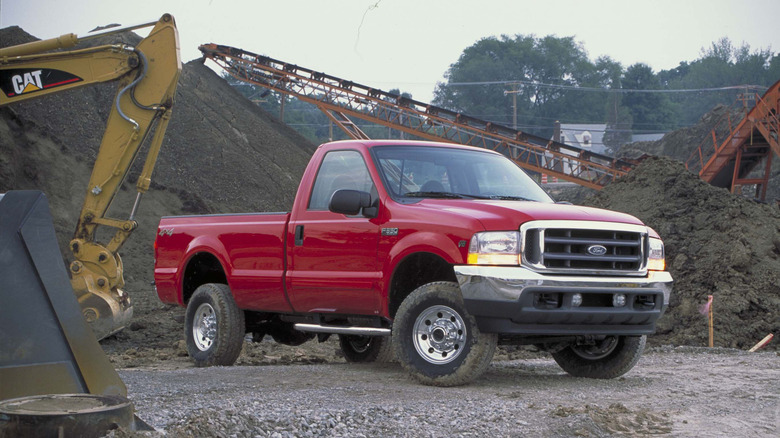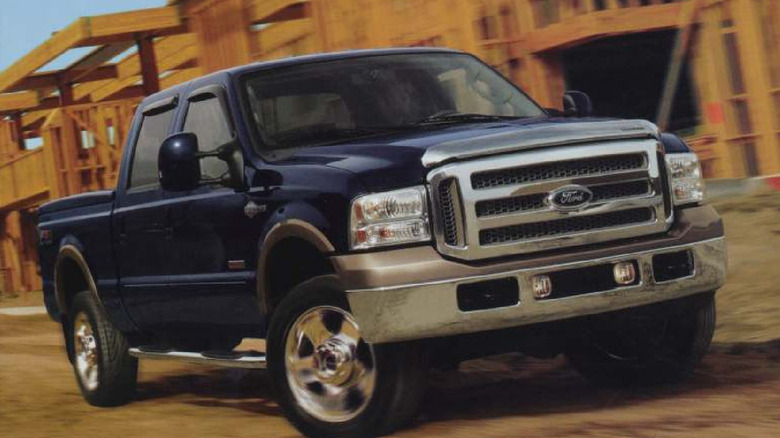What's The Worst Ford Diesel Engine, According To Drivers?
Typically, most people associate the common Ford Super Duty with the classic image of a perennial work truck — something designed to run for hundreds of thousands of miles to generate revenue for its owner. But every car, no matter how seemingly durable, has the potential to hide a true lemon under the hood, and even the venerable Super Duty is no exception. The Power Stroke's fundamental design dates to the 1980s, and not much has changed since then; from the first 7.3L Power Stroke that debuted in 1994 to the modern examples three decades later, hardly anyone associates these engines with poor reliability, save for one specific problem child: the infamous 6.0.
The 6.0L Power Stroke represents the engine's second iteration, lasting from 2003 to 2007. It features a number of features that were innovative for the time, with the crown jewel being its variable geometry turbocharger. A variable geometry turbo, put simply, is a type of turbocharger with mechanical vanes that open and close to redirect airflow inside, like a tiny wind tunnel. This either speeds up or slows down the airflow, resulting in optimal boost levels depending on factors like throttle position, engine RPM, and so on. It was also one of the principal problems behind the 6.0's reputation for unreliability, among several other factors, the worst of them being blown head gaskets.
The 6.0 was a creature of extremes for Power Stroke fans; you either loved it or hated it, with little in between. Often, this relied upon specific upgrades, such as a new turbo and better head bolts to fix the aforementioned issues, but opinions nevertheless remain divisive. Let's dive in and sample what owners and experts have to say about this power plant.
Why it earned its poor reputation
The main reason why the 6.0 replaced the much-beloved and sadly discontinued 7.3 in the first place was stricter emissions policies, and this seems to be where most of its issues originated. Theoretically, for instance, a variable geometry turbo is more efficient because turbo lag is less of a problem, and you don't sacrifice top-end power or low-end torque. Moreover, the engine features an exhaust gas recirculation (EGR) system, which helps reduce harmful emissions by lowering combustion temperature. This also proved problematic in the 6.0, as it became clogged with soot from the exhaust and poorly circulated oil, either blocking the system or keeping it permanently open.
Outside of these issues, however, the engine's oil cooler was also poorly designed, being built into the front of the engine block. When the system gets clogged, the problem compounds and spreads throughout the rest of the engine, affecting the aforementioned EGR system as well as causing all the usual issues associated with oil pressure loss. This marks the point at which everything dominoes, leading experts to recommend relocating these components. Many owners with OEM coolers experience significant problems ranging from coolant leaks to blown head gaskets, and often have mechanics commonly replace these components with aftermarket alternatives.
Lastly, experts and mechanics cite the head bolts as a common failure point. The 7.3L Power Stroke that preceded the 6.0 features six head bolts, whereas the 6.0 only features four. This makes the engine particularly temperamental to power increases and high-stress work environments, further tarnishing its reputation within the Power Stroke community. This problem was partially solved with the bolts being enlarged in the 6.4 before being increased to 18 bolts per head in the 6.7.
Are there any redeeming factors?
The biggest takeaway here is that the 6.0L is actually a reliable engine (though not as reliable as many other Power Stroke models), but only if you do the maintenance and replace the oil cooler with either a better alternative or a relocation kit. Owners often cite this and other crucial modifications, like EGR delete to make it reliable, generally bemoaning the engine in its factory configuration, owing to its problematic design. Therefore, assuming the engine is 100% factory-fresh, with nothing changed, it's likely the worst — or certainly one of the sketchiest — diesels out there. Either you get one that works or one that fails catastrophically with little variation in between, which isn't reassuring to someone looking to buy one.
Because the engine effectively requires modification to be good, it can be argued that it's either not a good engine or simply one that needs a little TLC to run well. In either case, however, owners tend to love the 6.0 in this format, with the modifications focused on reliability rather than outright power (owing to blown head gasket issues).
There have been documentary-length videos showcasing the woes of the 6.0 Power Stroke, so perhaps it's not too surprising that this engine holds one of the worst reputations for unreliability across diesels in general. But with proper maintenance procedures and upgrades, these engines are perfectly capable of running deep into the hundreds of thousands of miles, making the 6.0 a somewhat specialized powerplant — owners unfamiliar with its specific quirks are likely to run into more issues.
Our methodology
We scoured dozens of sites, forums, accredited journals, video testimonials, expert opinions, and more to shed some light on this polarizing powerplant. Owing to the plethora of documentation surrounding the 6.0 Power Stroke, there's a diverse array of voices both for and against this engine, with sources claiming that it either runs exceptionally well or shockingly poorly. This makes it especially difficult to pin down certain factors as fact or fiction; as such, we've cross-referenced all these points across multiple sources, refuting many along the way.
Like any engine, a Power Stroke is only as good as its previous owner. Engines that have been mistreated or poorly maintained are more likely to be problematic, and we've taken that into account as well. As such, we've discounted vehicles that have been sitting around for years or those with excessive modifications, as these do not accurately reflect the average 6.0 Power Stroke experience. We've instead focused primarily on two groups: those with entirely stock builds, and those who've built these engines specifically for reliability, to see how they've circumvented the engine's inherent defects.
If you're looking to purchase a 6.0 Power Stroke, always bear in mind that these engines are fundamentally different beasts, depending on whether they're stock or upgraded; research specific mods and their recommendations as needed.



